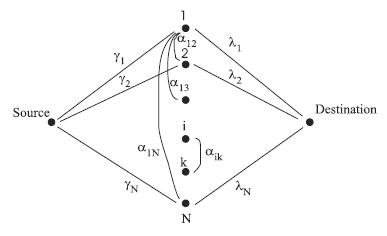TR2007-082
Performance of Fountain Codes in Collaborative Relay Networks
-
- , "Performance of Fountain Codes in Collaborative Relay Networks", IEEE Transactions on Wireless Communications, Vol. 6, No. 11, pp. 4108-4119, November 2007.BibTeX TR2007-082 PDF
- @article{Molisch2007nov,
- author = {Molisch, A.F. and Mehta, N.B. and Yedidia, J.S. and Zhang, J.},
- title = {{Performance of Fountain Codes in Collaborative Relay Networks}},
- journal = {IEEE Transactions on Wireless Communications},
- year = 2007,
- volume = 6,
- number = 11,
- pages = {4108--4119},
- month = nov,
- issn = {1536-1276},
- url = {https://www.merl.com/publications/TR2007-082}
- }
- , "Performance of Fountain Codes in Collaborative Relay Networks", IEEE Transactions on Wireless Communications, Vol. 6, No. 11, pp. 4108-4119, November 2007.
-
MERL Contact:
-
Research Area:

Abstract:
Cooperative communications, where parallel relays forward information to a destination node, can greatly improve the energy efficiency and latency in ad-hoc networks. However, current networks do not fully exploit its potential, as they only use traditional energy-accumulation, which is often used in conjunction with repetition coding or cooperative space-time codes. In this paper, we show that the concept of mutual-information-accumulation can be realized with the help of fountain codes, and leads to a lower energy expenditure and a lower transmission time than energy accumulation. We then provide an analysis of the performance of mutual information accumulation in relay networks with N relay nodes. We first analyze the quasi-synchronuous scenario where the source stops transmitting and the relay nodes start transmitting after L relay nodes have successfully decoded the source data. We show that an optimum L exists and is typically on the order of 3 or 4. We also give closed-form equations for the energy savings that can be achieved by the use of mutual-information-accumulation at the receiver. We then analyze and provide bounds for an alternate scenario where each relay node starts its transmission to the destination as soon as it has decoded the source data, independent of the state of the other relay nodes. This approach further reduces the transmission time, because the transmission by the relay nodes helps the other relay nodes that are still receiving.
Related News & Events
-
NEWS IEEE Transactions on Wireless Communications: publication by Jinyun Zhang and others Date: November 12, 2007
Where: IEEE Transactions on Wireless Communications
MERL Contact: Jinyun Zhang
Research Area: CommunicationsBrief- The article "Performance of Fountain Codes in Collaborative Relay Networks" by Molisch, A.F., Mehta, N.B., Yedidia, J.S. and Zhang, J. was published in IEEE Transactions on Wireless Communications.
